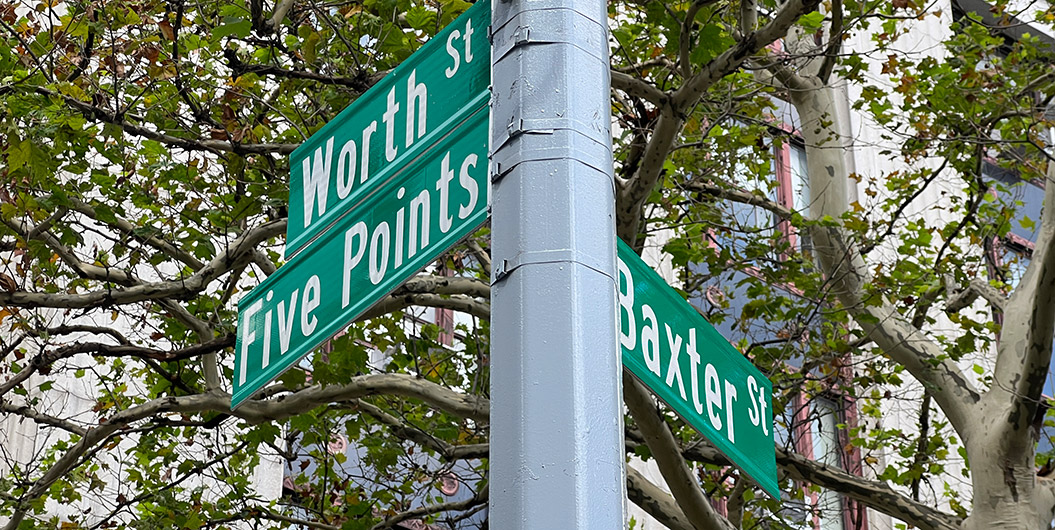Five Points
The corner of Baxter and Worth Streets behind government buildings seems like an ordinary intersection, but on closer inspection one might notice the street sign also says “Five Points”. In the 19th century, this intersection was the center of the notorious neighborhood called Five Points, popularized in the film Gangs of New York. It got it name because this intersection used to be a crossing of five streets. Only two of the streets currently exit, Baxter, which was called Orange and extended south, and Worth, which was called Anthony and which ended at this intersection. The east part of Worth is from the 20th century. Another street called Cross also went through the intersection. A bit of this street is still left east of the park and is now called Mosco. Thus, a five way intersection called Five Points, which was also the name of the neighborhood around it.
Slightly northwest of the intersection, there used to be a pond called The Collect Pond, which was one of the main sources of fresh water for the city. A painting from 1798 depicts it as a lovely bucolic place. However, as the city grew, industry began to build up next to the pond. Places such as breweries and slaughterhouses would use the water to make their products, but also dump their waste into the pond. Soon, it became very polluted, with a horrible smell and diseases spreading around it. Anyone who could afford it, left the area, leaving only the poorest people here. In 1811, The pond was filled in, but things didn’t get much better. Noxious gasses would seep up from the ground, and being a depression, sewage and mud would accumulate in it.
In 1827, two things happened that would greatly affect The Five Points. New York State abolished slavery and Britain opened emigration from Ireland. Soon there was an influx of emancipated slaves, along with freemen, as well as Irish immigrants. As some of the poorest residents of the city, they ended up living in The Five Points as one of the few places they could afford. It became densely populated, filled with poverty, crime, and disease.
Where the New York State Courthouse now stands south of Worth Street was another smaller pond called The Little Collect Pond. It was also filled in, but was too unstable for buildings, so a square was created over it called Paradise Square, the infamous center of neighborhood and one of the few open spaces in it.
The Coulthard Brewery sat next to the Little Collect Pond, but it had to close down after the pond was filled. It became a flop house called The Old Brewery, now on Paradise Square, where for a few pennies, one could hope to find a place on the floor in a crowded room. Up to 1000 people lived in it, and at its peak, there was an average of one murder per week in it. In 1852, a religious group, Methodist Ladies of the Mission, purchased it just to demolish it and replace it with a mission.
As for gangs, one of the most famous was The Bowery Boys, American born nativists who hated immigrants, Irish, and Catholics. Not only were they a street gang, they also ran a volunteer fire department. Other nativist gangs also had fire departments and would compete to put out fires, often trying to block other departments from fighting the fire. Sometimes they would fight so much that no one actually put out the fire. In addition to a fire department, they also had a theater where they would write, direct and act in their own shows.
The Bowery Boys were a bit better off economically, so did not actually live in The Five Points, but in nicer areas nearby. They had a certain look with a top hat, colored shirts, and boots. All dressed alike, they would come into The Five Points to confront, harass, and intimidate their enemies.
The biggest rivals of The Bowery Boys were the Dead Rabbits, an Irish immigrant gang who lived in The Five Points. They were too poor to afford matching outfits, so they identified themselves by marching around with a dead rabbit on a spear.
The most famous battle between these two gangs occurred on July 4th, 1857. American Independence Day is a big holiday for a nativist gang like The Bowery Boys, so they were having a big celebration at one of their clubhouses. The Dead Rabbits knew this and went to attack them. The Bowery Boys were able to beat The Dead Rabbits back to Paradise Square. News of this fight spread, and other nativist gangs and immigrant gangs joined forces in a battle that lasted two days with a thousand gang member taking part. It left around 80 people dead and became known as The Dead Rabbits Riot.
While the gangs get much of the attention, there was also a lot of African American history in The Five Points. Tap dancing was created in the dance halls here by former slaves and freemen, who took traditional African dances and incorporated the jigs of their Irish neighbors.
In the 1880s, a Dutch immigrant, Jacob Riis, began to document life in The Five Points and other poor areas of the city using photography. He published these photos in a book called How the Other Half Lives, which came out in 1890. It was the first time the general public saw the horrible conditions and poverty in which immigrants and lower classes lived. There was a sense of shock and outrage, along with growing political pressure to do something.
Where the park is now, was one of the worst parts of The Five points with overcrowded tenements and shanties. Numerous back alleys provided gangs places to gather, the most notorious of which was called Bandits Roost. The area was named Mulberry Bend because of the slight curve in Mulberry Street there, and was one of the areas documented by Riis.
With growing public pressure, the entire area of where the park now sits was condemned in 1897. Everything was razed and the park was created. Construction of the Brooklyn Bridge from 1870 to 1883 and the Manhattan Bridge from 1901 to 1909 also razed large areas on the outskirts of The Five Points. The courthouse began construction in 1913, demolishing the area around Paradise Square.
One step at a time during these years, The Five Points disappeared as a neighborhood. The neighborhood to the east of the park, now part of Chinatown, is called Two Bridges as it is between the two bridges. The area to the west of the park is called Civic Center for the many government buildings it contains. Although Five Points is gone, the street sign on Baxter and Worth marks the spot of one of the most notorious neighborhoods in New York City.
Visit the Five Points on our Mafia in Little Italy Tour.
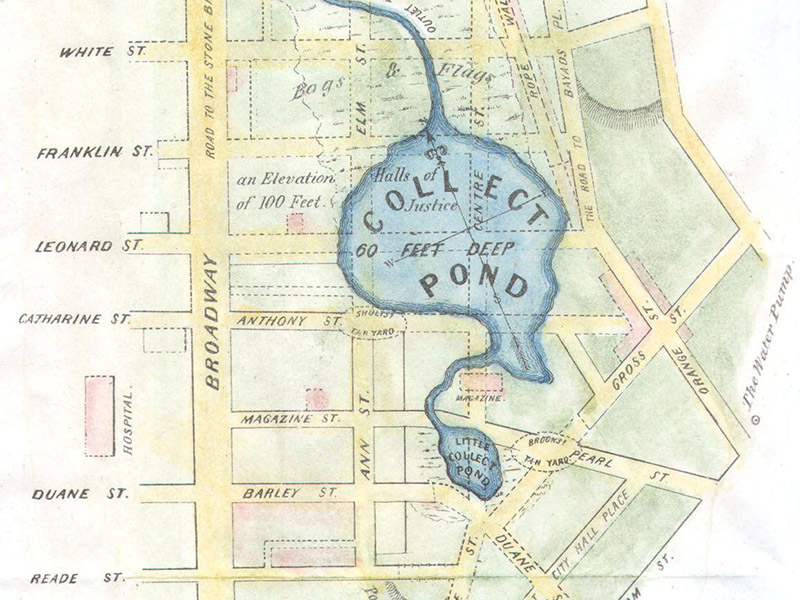
Map of The Five Points 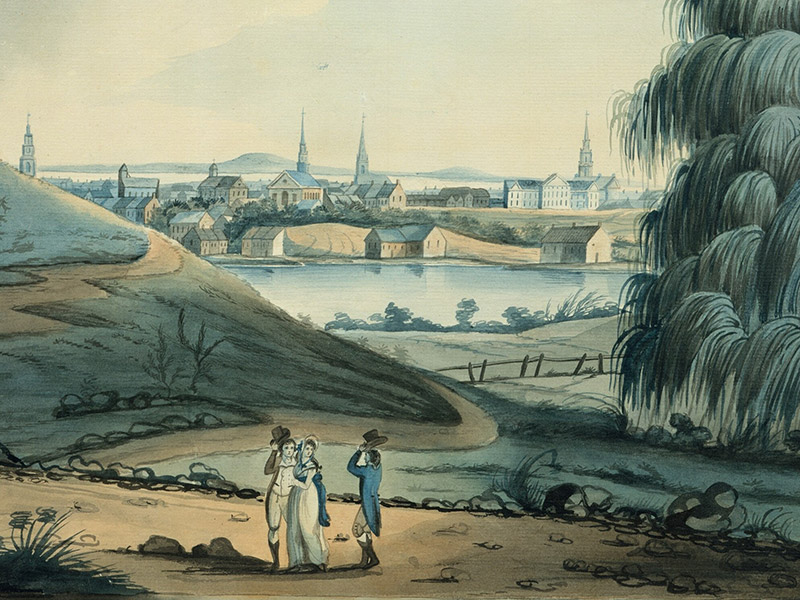
The Collect Pond in 1789 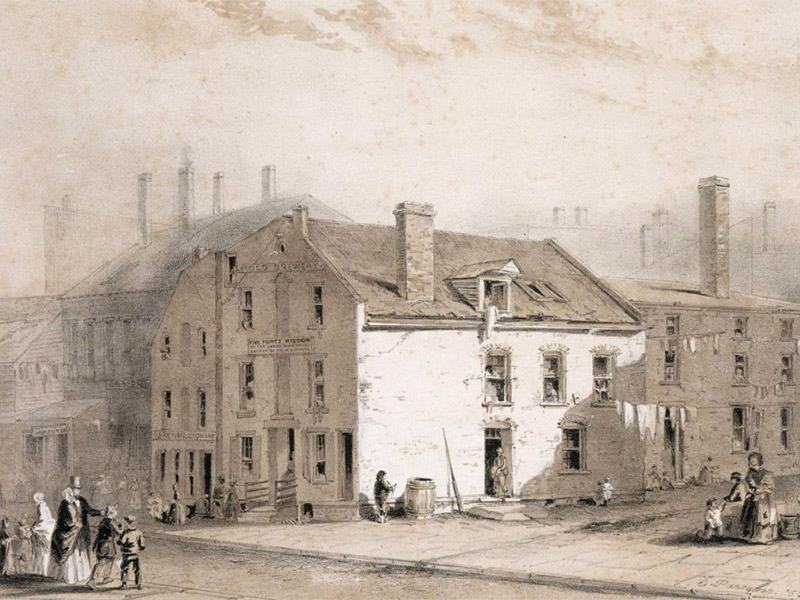
The Old Brewery in The Five Points 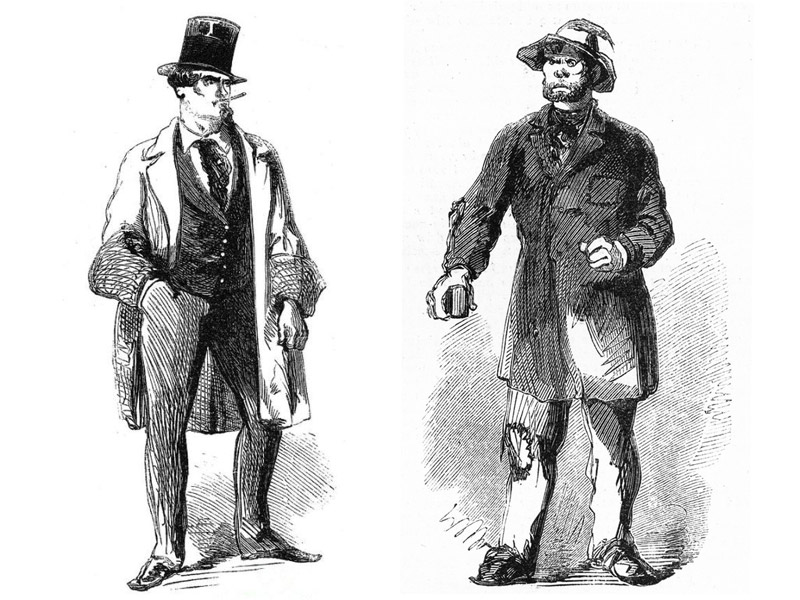
A Bowery Boy and Dead Rabbit 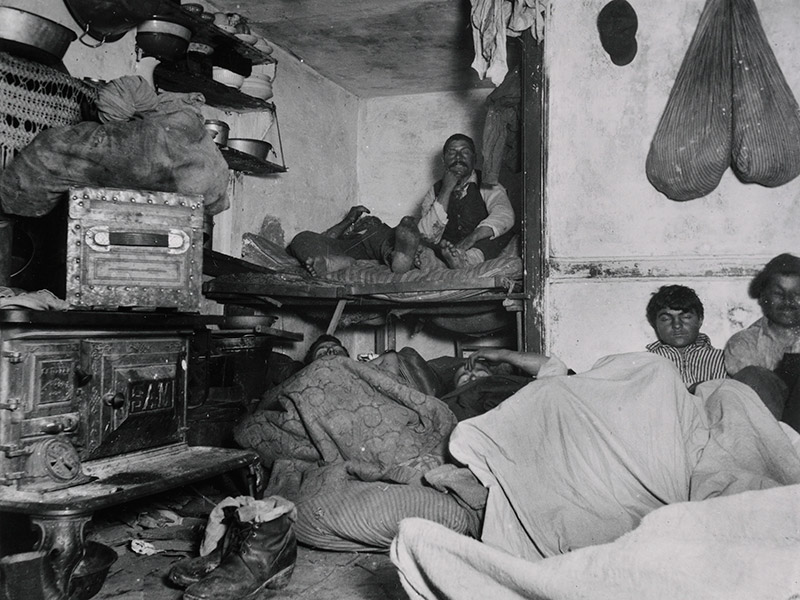
A Boarding House in Mulberry Bend by Jacob Riis 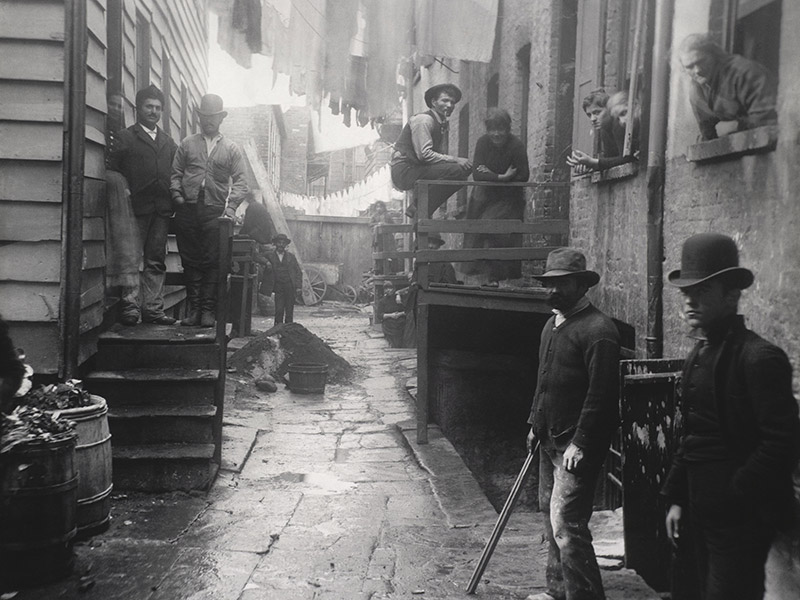
Bandits Roost by Jacob Riis
